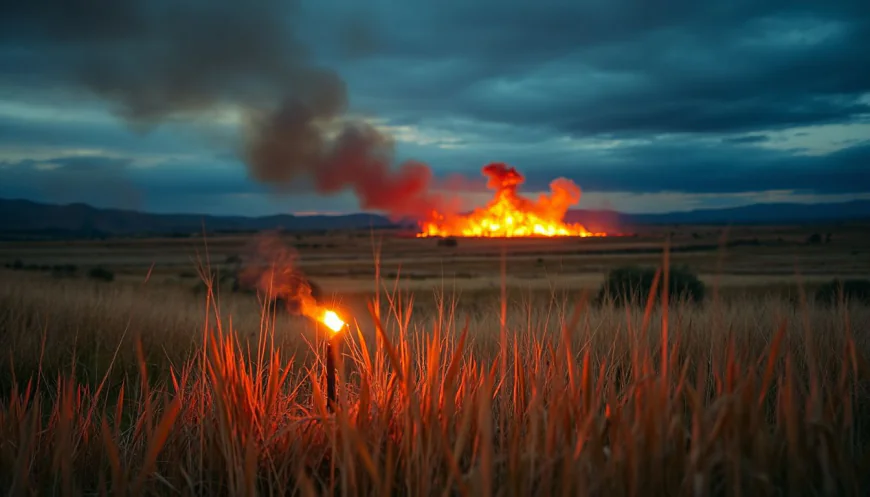A Spark Can Start a Fire That Burns the Entire Prairie: Understanding the Power of Small Actions
A tiny spark. It might seem harmless, but it holds the power to ignite something much bigger. Think about a single flame starting a wildfire that sweeps across a vast prairie. That tiny spark can lead to destruction or renewal, depending on how we handle it. Small actions or events can quickly grow into large, uncontrollable disasters—whether in nature, society, or the economy. Recognizing this risk is crucial. Being aware and responsible can prevent a small mistake from turning into a massive problem.

The Science Behind Sparks and Wildfires
How Sparks Are Created
Natural causes like lightning strikes often start wildfires. Human activities contribute too—walking with a lit cigarette, faulty machinery sparking, or a campfire left unattended. For a spark to ignite a fire, certain conditions must be present. The air needs to be dry, the vegetation dry and easy to burn, and sometimes wind helps carry the flames fast.
From Spark to Blaze: The Fire’s Growth
Once ignited, a fire can spread quickly. If the ground is dry and the wind strong, flames race across grasslands or forests. Dense vegetation acts like kindling, fueling the fire's growth. It’s a process of escalation—what starts as a small spark can turn into a raging wildfire in no time.
Real-world Data on Wildfire Causes
Studies show that nearly 90% of wildfires are caused by human activity, often starting with a spark. For example, California experiences hundreds of wildfires annually, many traced back to discarded cigarettes or electrical faults. These tiny starting points can grow into destructive fires, burning thousands of acres and costing millions in damages.
Environmental and Ecological Impact of Prairie Fires
The Role of Fires in Ecosystems
Fires are not always destructive. Some ecosystems depend on periodic fires to stay healthy. Naturally occurring fires clear out dead plants, promote new growth, and help certain plants reproduce. In prairie landscapes, occasional fires prevent invasive species and maintain plant diversity.
Human Impact and Uncontrolled Fires
When fires escape control, they cause real harm. Wildlife loses homes, soil erodes, and water sources become contaminated. Landmark disasters, like the California wildfires, have caused thousands of animals and plants to perish, leaving long-lasting scars on ecosystems.
Prevention and Controlled Burns
Fire management teams use controlled burns—deliberate, managed fires—to reduce the risk of big wildfires. These burns remove dry brush, making it less likely that a small spark will turn into a wild blaze. They act like a safety valve, keeping ecosystems healthy and fires manageable.
Societal and Economic Consequences
Community Risks and Losses
Wildfires don’t just burn land—they threaten lives and homes. Entire towns can be evacuated in moments. Many residents lose everything, and rebuilding takes years. Recent wildfires in Colorado and Australia highlight how small sparks can devastate entire communities.
Economic Costs
Fighting wildfires costs billions each year. Expenses include firefighting crews, equipment, damaged property, and environmental cleanup. Insurance claims soar after a big fire, and many areas face long-term economic setbacks. The cost of ignoring small sparks is often much higher than proper prevention.
Expert Opinions on Fire Prevention
Fire experts stress that early action is key. "Stop small sparks before they turn into wildfires," says one fire chief. Education about fire safety and quick response plans save lives and reduce damage. Prevention begins with simple steps—like watching cigarettes and safe outdoor practices.
How Small Actions Can Prevent Large Disasters
Personal Responsibility and Vigilance
Everyone can make a difference. Properly disposing of cigarettes, avoiding outdoor fires during dry seasons, and being cautious with machinery reduce risk. Think of yourself as the first line of defense against wildfire disasters.
Policy and Community Initiatives
Communities play a big role in fire prevention. Burning bans during droughts, fire safety education, and neighborhood watch programs all help. Well-informed residents and strict regulations can reduce risky behaviors that cause fires.
Actionable Strategies
Implement firebreaks—strips of land cleared of vegetation—around homes and communities. Conduct controlled burns to reduce fuel build-up. Keep an eye on weather reports and danger levels. A little effort goes a long way in preventing a spark from becoming a disaster.
Lessons Learned and the Power of Small Actions
Historical Examples of Small Sparks Leading to Major Changes
History shows us that tiny causes can lead to big effects. The Great Fire of London in 1666 started with a small oven fire. Though different, many wildfires started with minor sparks, but their impacts changed landscapes forever.
The Role of Collective Responsibility
We all share responsibility. Every effort counts—whether it's reporting a risky situation, following safety rules, or participating in community fire plans. Small actions add up to strong defense against wildfires.
How Awareness Can Spark Change
Education sparks understanding. When people learn about fire risks and prevention, they are more likely to act responsibly. Spreading awareness can turn individuals into community defenders, stopping fires before they start.
Conclusion
A tiny spark can ignite a prairie fire that consumes everything in its path. That simple fact reminds us how small actions can lead to big consequences. Whether in nature, society, or our own lives, prevention and responsibility matter. We hold the power to stop disasters before they begin. By staying alert, being cautious, and working together, we safeguard ecosystems and communities from the devastating power of a single spark. Remember, prevent the spark today—protect what matters tomorrow.



 VARSHITHA
VARSHITHA